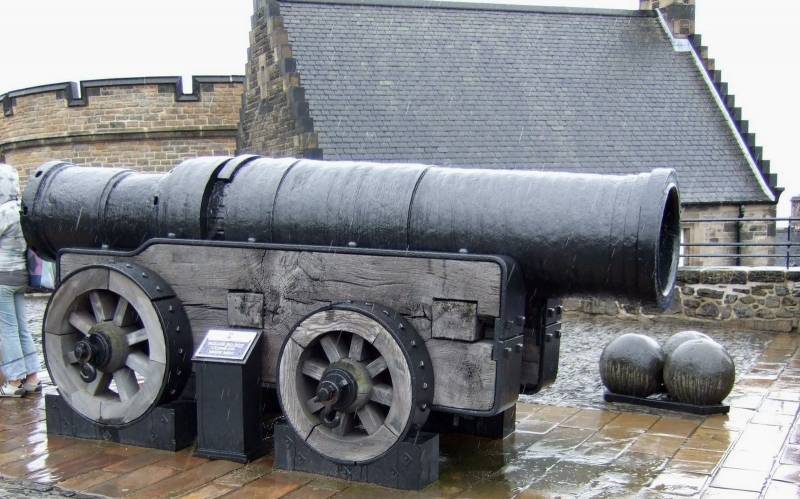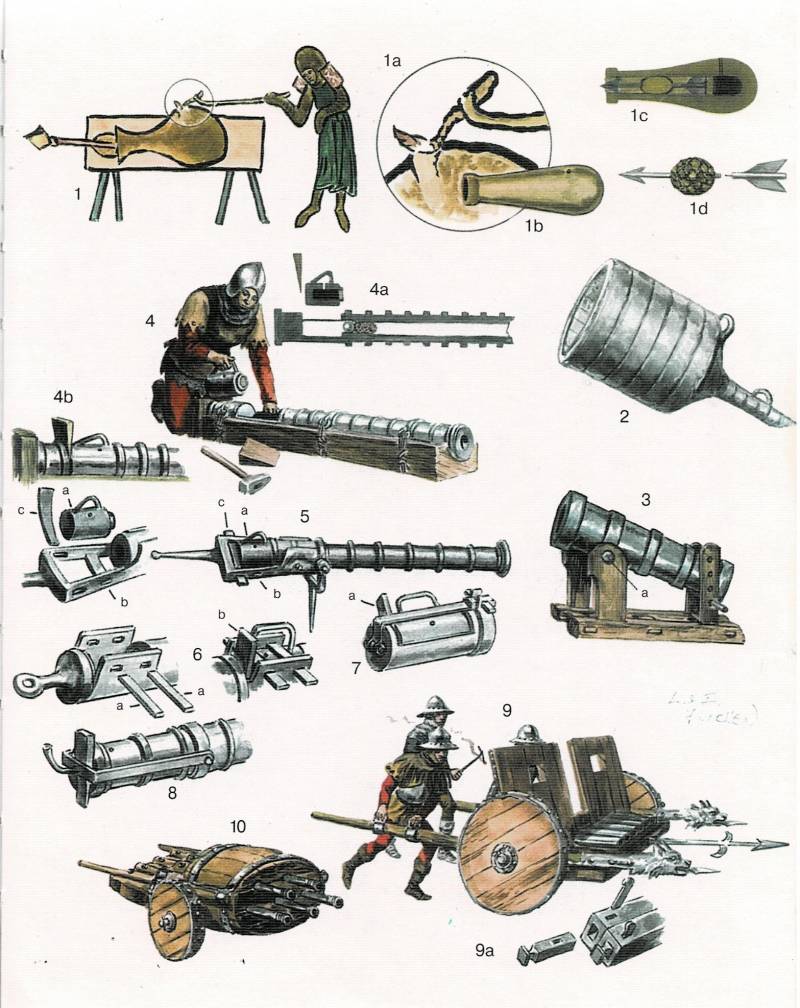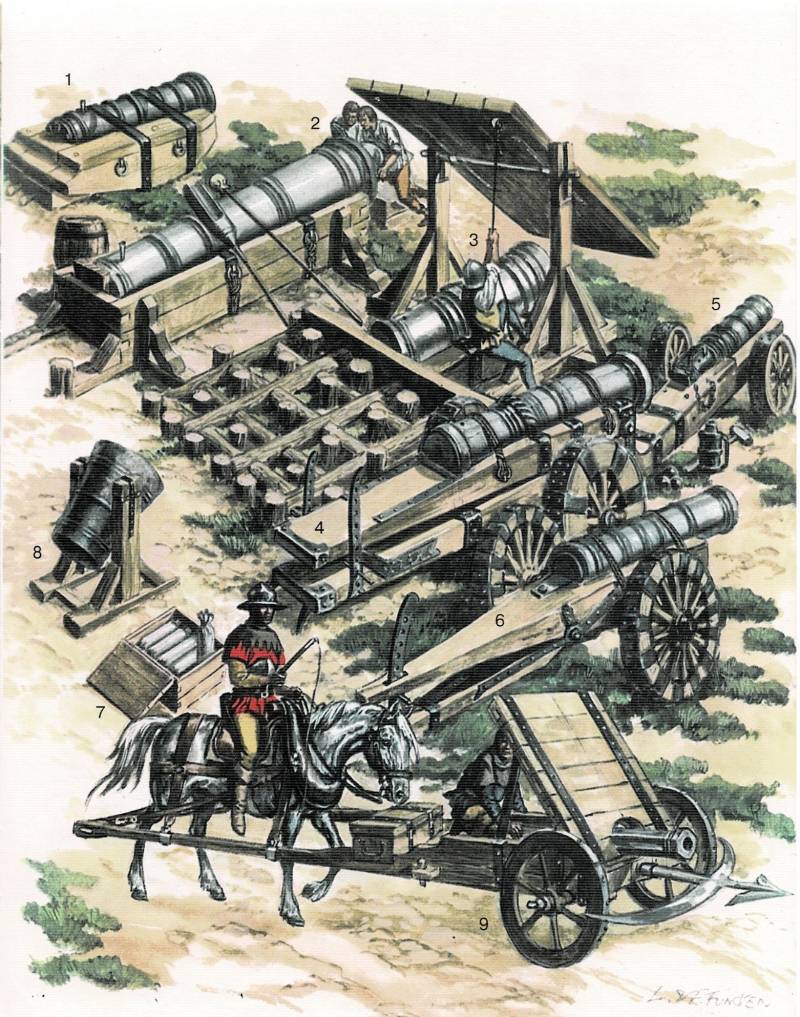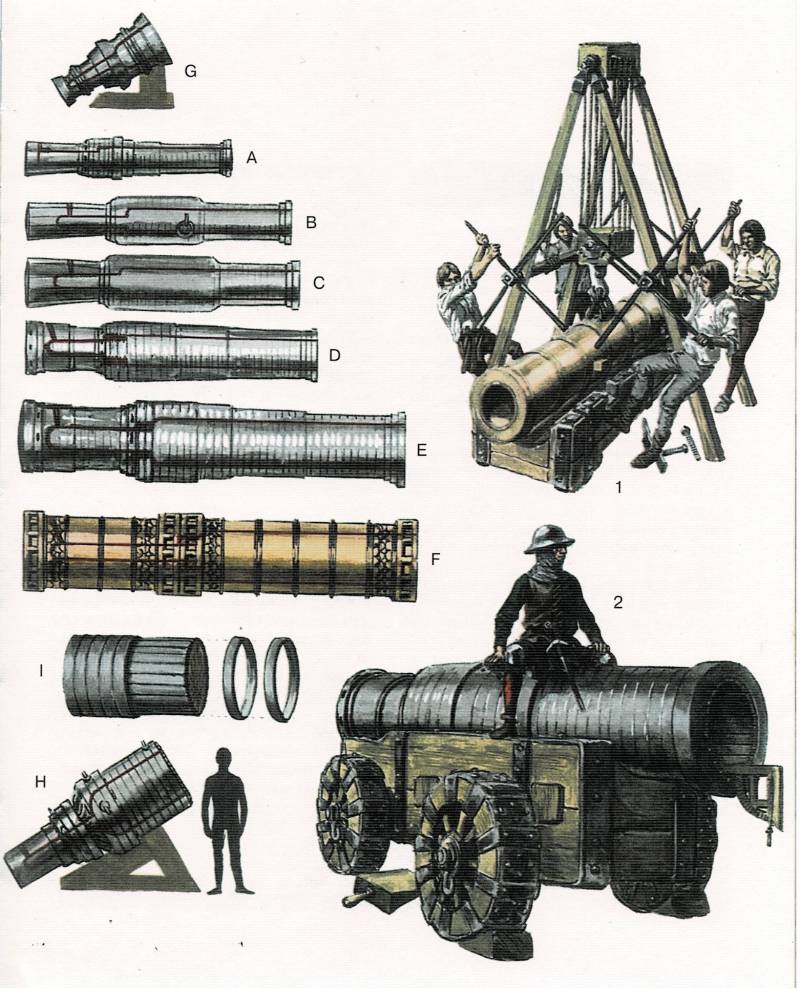Carriages and barrels from F. and L. Funken

Bombard "Mons Meg" in Edinburgh. Modern look
thunder and earthquake
and with a strong voice, a storm and a whirlwind,
and the flame of an all-devouring fire.
Exodus 29: 6
stories about weapons. And it so happened that the topic of medieval artillery, as well as artillery of the transitional period from the Middle Ages to the New Age, was of great interest to our readers, and very often in detail. For example, one of them was interested in the device of the gun carriages of the very first guns.
And although other readers even posted their images in the comments (for which they are both honored and thanked!), I think it would be interesting to show their device based on the illustrations from the book we have already mentioned here by Liliana and Fred Funken. Moreover, they did not draw them from their heads, but on the basis of many corresponding images of artists of that time. I think it will be both interesting and instructive, and will also remove all questions on this topic.

The very first tools and their devices
So, let's start with the fact, well known to most VO readers, that the first known image of a cannon was found in an English manuscript by Walter of Millimet (or Walter of Millimet), which dates back to 1326 (Fig. 1). The Funkens indicate that some experts at the time when they wrote their book (mid-70s of the last century) disputed this date, believing that such tools did not exist at that time.
The reason is the unusual appearance of the gun itself, which looks like a copper jug, and, most importantly, its carriage, which seems to be pure fantasy. However, it is possible that Walter of Millimetsky himself did not see these weapons, but drew from the stories.
But in figure 1a, which is an exact enlarged copy of the original fragment, both the wick brought to the fuse and its holder in the hand of the “shooter” are clearly visible. The incredible shape of the gun carriage proves only that the illustrator had at his disposal only a brief description of the new weapon - fig. 1b. The cannon projectile in Fig. 1, 1c is depicted extremely naively, such a projectile, of course, could never have been used.
However, there is a bas-relief image on one of the tiles in Edinburgh Castle, dating from the 1th century, which shows the projectile shown in fig. 1, XNUMXd.
In the materials of the cycle, we have already talked more than once about the fact that, having started our history from the “copper jug”, European artillery then went along the most difficult path of creating trunks from iron bars, fastened, again, with iron hoops. And not only guns did this, but also mortars. Such, for example, was forged, made around 1346, approximately 50 cm in caliber and 1,22 m long (Fig. 2).
For a long time there were no trunnions on the trunks. But the Funkens found an image of a wrought iron bombard with pins in one of the copies of the Book of Marco Polo, dating from about 1400, as evidenced by the costumes of the characters there (Fig. 3). For some reason, at the beginning of the 4th century, tools began to be made with a removable powder chamber (Fig. 4: 4a, XNUMXb).
Wegler gun (Fig. 5) with trunnions and a removable powder chamber (a), its socket (b) and a fixing wedge (c) in the breech. The variety of such systems is amazing. Here, for example, is a tool from the end of the 6th century. (Fig. XNUMX), the breech of which has high side walls, with chamber locks (a) and a thrust bearing (b).
And here is the tool lock (Fig. 7), which is equipped with an L-shaped hinged lock and thrust bearing (a) of the late XNUMXth century, and the tool lock with ... a U-shaped stirrup of the late XNUMXth century.
Ribadekin (Fig. 9) in the form of an "organ" of six cannons cast from iron and loaded from the breech, called in Germany "Todtenorgel" ("organ of death"). It could well be used to storm the fortress gates, broken by heavy artillery. Its barrels were also loaded from the breech, and it is clear why (Fig. 9: 9a).
German ribadekin of five barrels, already loaded from the muzzle (Fig. 10), around 1450.
Here we have not yet seen any special carriages, but this does not mean that their diversity, just like the variety of gun barrels, did not exist at that time.

Artillery gun carriages of the XNUMXth century
Here is a bombard on a rocking carriage, the beginning of the 1th century (2). A giant bombard in a gun carriage. Moreover, this type of carriage was used during sieges, up to the first decades of the 3th century (XNUMX). During the siege, artillerymen were covered by fixed mantles or, on the contrary, as in this case, by movable shields with loopholes (XNUMX).
To dampen the recoil of the gun, the “devices”, although primitive, were powerful: for example, pointed logs hammered into the ground, against which the breech of the gun rested. The mere appearance of such "fiery pipes" often forced the garrisons of fortresses to capitulate, since their power was well known to them. For example, one of the walls of the Tannenberg fortress collapsed after only two shots from the Frankfurt cannons. To the left of the gun, you can see the shuflu (“spoon” for filling the barrel with gunpowder) and the breaker of that time.
Carriage in two parts connected in front by a hinge, circa 1450 (4). The entire weight of the gun at the time of aiming fell on the upper part of the carriage, which, however, was not very convenient, as was the attachment of the barrel to the carriage with ropes. Even then, “monolithic gun carriages” in the form of a tuning fork with a wedged removable chamber (5) were also used. A removed chamber and a wedge hammer are depicted next to the gun.
Two-part gun carriage hinged behind the powder chamber, circa 1470 (6). This design facilitated aiming, the main weight of the gun lay on the axis.
Caps with powder charges (7). It is generally believed that this invention was made much later, but their image is found in a manuscript of the second half of the XNUMXth century.
Miniaturists of the 8th century rarely give us a satisfactory representation of gun carriages. Moreover, images of mortars (XNUMX) are especially suspicious. They seem implausible, or at least incomplete. Under the influence of recoil, the gun inevitably had to overturn such a “roost”.
By the way, it is amusing to note that huge tools never aroused the interest of miniaturists, who were completely unaware of the great importance their descendants, historians-researchers, would attach to their testimonies. In reality, the mortars had to be mounted almost vertically on a massive carriage, tilted with wedges to achieve the desired firing angle.
Ribodekin of the middle of the 9th century (1340). It can be seen as the forerunner of the modern self-propelled gun, in any case, its most important components are already present: this gun, armor and engine. The name of this weapon is sometimes deduced from the ribod, a part used to pull giant crossbows, since these tools originally fired arrows. The accounting books of the city of Bruges in XNUMX call this tool a "new machine".

Dimensions of artillery pieces of the XNUMXth century
We often say that the guns of the XNUMXth century were very large, and that is why the walls of knights' castles could not resist them. However, in order to visualize exactly how big they were, it is best to depict them on the same scale as a human figure, which is exactly what L. and F. Funkenov did in this illustration.
Here is a way to install a cannon on a carriage at the end of the 1th century (Fig. XNUMX). And this is the famous gun "Mons Meg" ("Margot de Mons") on a wheeled carriage. Such guns were intended for punching holes in the walls and were mounted on strong wheeled wooden carriages or beds, and did not have any vertical aiming mechanism due to their enormous weight.
It should be noted, however, that the bas-relief in Edinburgh Castle depicts gunners reinforcing a wedge under the mouth of the Mons Meg. Although it is not clear whether this was enough to lift such a gigantic weight. This "Margot de Mons" fired the last time in 1682 with a blank shot, saluting the Duke of York, the future King of England, James II, who arrived in Scotland. Loaded with much stronger gunpowder than that used in the XNUMXth century, it quickly collapsed in the depths of the chamber near the screw thread (see Fig. D), which eventually led to the breakage of two rings on the barrel.
Abandoned and obscured until 1754, Mons Meg was sent to the Tower of London along with other old tools that had fallen into disuse. In 1829, as a result of the patriotic efforts of the novelist Walter Scott, the bombard was moved to Edinburgh, where it still attracts tourists today.
Well, now let's look at the comparative dimensions of the XNUMXth century guns.
Here is a mortar of Bourguignons from the Oxy army, captured by the Swiss after the Battle of Morata in 1476. Length: 2,75 m. Weight: 2 kg. Caliber: 000 cm. Core weight: 36,5 kg (A).
English bombard "Michelette". Length: 3,53 m. Weight: 3 kg. Caliber: 500 cm. Core weight: 37 kg (B).
Another English bombard of the same type. Length: 3,64 m. Weight: 5 kg. Caliber: 500 cm. Core weight: 45 kg (C).
These were undoubtedly the first bombards known to us. Perhaps they were made in Flanders, but it is not known at what time, and abandoned by the British after the defeat at the fortress of Mont Saint-Michel in 1434.
Bombard "Mons Meg" was forged in Belgium by J. Cambier in 1449 and sent by Philip the Handsome to King James II of Scotland in 1457. Length: 3,90 m. Weight 6 kg. Caliber: 600 cm. Core weight: 50 kg (D).
Erich Egg in his book "Cannons" claims that its stone core flew approximately 263 m. But the iron core, according to the manuscripts of contemporaries, flew only 129 m due to its greater weight.
Bombard "Dulle Griet" ("Mad Margo") is a Ghent bombard of the middle of the 1452th century. In 1578, during the siege of Audenard, she was captured by the auxiliary army of the Bourguignons, but returned to Ghent in 5,025. Length: 16 m. Weight: 400 kg. Caliber: 64 cm. Weight of the shot: 340 kg (E).
The "Mohammed Cannon" or "Dardanel Mohammed" is a gun cast by the Turks from bronze, possibly in 1464. In 1867, Sultan Abdul Azis presented it to Great Britain. Length: 5,25 m. Weight 7 kg. Caliber: 500 cm. Core weight: 66 kg (A).
Guns D, E, F were divided into parts at the junction of the powder chamber and the muzzle with the help of levers inserted into the holes visible in many drawings and photographs. It is unlikely that this system was used to facilitate the loading of guns. It is more likely that the purpose of such a device is to facilitate the transportation of a gigantic mass by dividing the barrel into parts.
All these guns, which have survived to this day, testify to the outstanding art of the masters of that era.
Here we also see a bombard-mortar (G), called the "Lurinsky bombard". It was cast in iron around 1420. Length: 1,44 m. Weight: 1 kg. Caliber: 500 cm. Core weight: 51 kg.
The bombardment from Stir (Austria), the first half of the 2,58th century, is also very impressive. The length of its trunk: 7 m. Weight: 100 kg (N).
A method of making a wrought iron cannon (Fig. A, B, C, E and H). Around the wooden model, iron plates are laid side by side - like barrel staves, then red-hot iron rings are successively put on them.
Drawings from A to H are made in the same scale; the silhouette of a person at the bottom of the page will give an idea of their size, if we consider the average human height of 1,70 m. The red line shows the shape of the bore and the powder chamber with the ignition hole.
In general, I think that this is a fairly complete and visual demonstration of all the features of gun carriages and gun barrels of the XNUMXth century.
Well, we have already talked about later guns in detail here. Someone, I remember, asked me to write about the tools of the XNUMXth-XNUMXth centuries, as well as the XNUMXth century. Well, perhaps this will be done a little later.
PS
As a source of illustrations, the 2002 Astrel / AST publication was used: Fred and Lilian Funken “The Middle Ages. The era of the Renaissance: infantry - cavalry - artillery.
Information